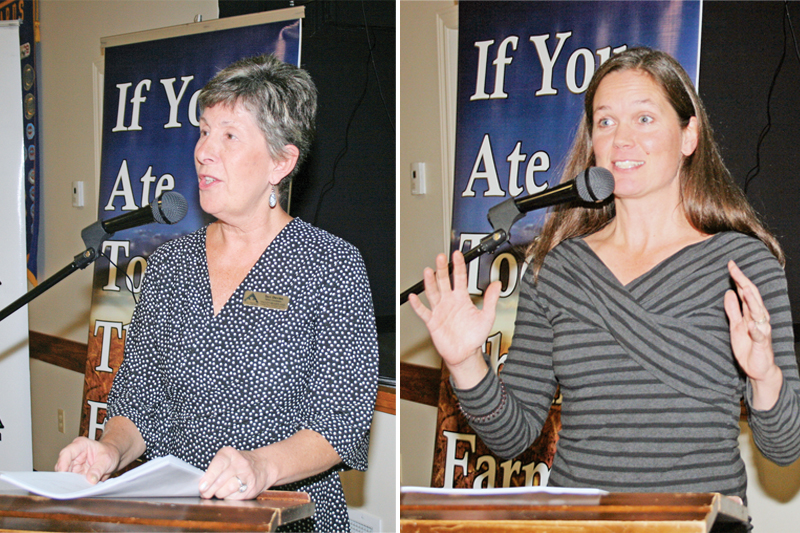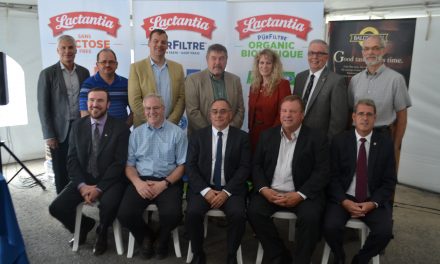Photo left, Teri Devine, coordinator of the Business Retention and Expansion (BR+E) project in Lanark County, invited members of the Lanark Federation of Agriculture (LFA) to be part of the BR+E project as she spoke at the federation’s AGM on Oct. 11. Photo right, Katie Nolan of OMAFRA was also a guest speaker at the LFA AGM. The BR+E process that Lanark County is following is based on an OMAFRA toolkit, which includes surveys, database management, training and ongoing advisory services to the coordinator and project partners. Pinder-Moss photos
by Dianne Pinder-Moss
AgriNews Contributor
LANARK COUNTY – The agricultural community is “an important piece of the economic puzzle” in Lanark County, and it is essential that their voice be heard.
That was the message from Teri Devine at the 2018 annual general meeting of the Lanark Federation of Agriculture (LFA) as she spoke about the Business Retention and Expansion (BR+E) project being undertaken in the county.
As the BR+E project moves forward, “it is important that the LFA be at the table,” the BR+E coordinator with Valley Heartland Community Futures Development Corporation (CFDC) told the approximately 80 people in attendance at the Lanark Civitan Hall on Oct. 11. “Have your say and provide your input.”
With the County of Lanark partnering with Valley Heartland CFDC to deliver the project, BR+E is “an effective economic development tool that provides real results,” Devine says.
As she explained to the gathering, BR+E is built on the idea that the majority of new jobs in a community come from existing businesses and those businesses “need to be nurtured and supported.
To illustrate that point, it was noted that, in Lanark County, 85 per cent of employment in 2016 came from small businesses that employed less than five people. That figure increased to more than 91 per cent when small businesses that employ less than 10 people were included.
As far as the agricultural community is concerned, EMSI data showed that 70 per cent of farms in the county that reported a formal payroll in 2017 employed one to four people.
“Farms are small business enterprises as well and are very important to the local economy,” Devine stated.
The BR+E process that Lanark County is following is based on an Ontario Ministry of Agriculture, Food and Rural Affairs (OMAFRA) toolkit, which includes surveys, database management, training and ongoing advisory services to the coordinator and project partners. First introduced in Ontario by OMAFRA in 1998, 265 BR+E projects have been undertaken since that time. Neighbouring Leeds-Grenville is currently in the process of doing a BR+E.
The implementation of a BR+E project in Lanark County was identified as a priority in the county’s Economic Development Strategic Plan 2018-2020.
Led by Valley Heartland, County of Lanark and OMAFRA with a 44-member leadership team representing eight municipalities, the strategic planning process took place in May-December 2017. As part of the process, a questionnaire was circulated to the general public.
More than 300 responses were received with respondents having “a lot to say”, according to Katie Nolan of OMAFRA who was also a guest speaker at the LFA AGM. And that included those in the agricultural community who completed the questionnaire.
Nolan, an agriculture and rural economic development advisor with OMAFRA, shared some of the feedback received. When asked about what makes Lanark County a great place to live/work/do business and play, the responses ranged from the “great” farmers, farms and agricultural products to agriculture opportunities to the importance of agricultural lands. Multiple respondents also made mention of locally grown food.
As part of her presentation, Nolan provided a picture of the county’s agricultural industry by the numbers.
Referring to the 2016 census results, she stated that there were 705 farms comprising more than 186,000 acres in total. Likewise, census data showed gross farm receipts of $55,231,957 and total farm capital of over $786-million.
The average age of the 1,040 farm operators recorded in the 2016 census was 57, up slightly from 55 in 2006. Despite the number of farms being reduced by 19.34 per cent and total farm area by close to 20 per cent in that time period, that trend was bucked by total farm cash receipts. Nolan noted that total farm cash receipts increased by 36 per cent between 2006 and 2016.
Of the $45.8-million in farm cash receipts for main commodities in Lanark County in 2016, dairy and calves and cattle headed the list with $10.75-million and $6.07-million respectively. Next was soybeans ($5.35-million) followed by program payments ($4.80-million). Program payments is comprised of income farmers received through the Business Risk Management suite of programs such as AgriInsurance, AgriInvest and AgriStability.
The agricultural sector was analyzed in detail by the data analysis working group in the development of the plan. Along with agriculture being identified as an area of opportunity in Lanark County from a workforce and local employment perspective by the working group, there was also recognition of opportunities that add value in processing, as well as partnerships in local food product development and distribution. Cross sector opportunities with agriculture, including knowledge-based, manufacturing and tourism, was cited as another possible action item. The working group also commented on possible producer opportunities in the cannabis industry.
“BR+E is one tool to work out what that strategy is going to be about,” Nolan stated in her presentation.
Devine made reference to the fact that BR+E was endorsed by the Ontario Federation of Agriculture (OFA) in its Agriculture Matters guide for municipal councillors and staff.
“Business retention and expansion studies (BR+E) can focus specifically on agriculture and food to determine specific needs and opportunities within the sector,” the guide states. “An agri-food BR+E can be particularly useful for determining whether specific infrastructure is needed (e.g. grain elevator, freezer storage facilities, distribution centres, etc.) or specific cluster development (e.g. craft beer and hops industry growth).”
Outlining what a BR+E is all about, Devine explained that the project uses volunteers to meet with local businesses, complete a survey with them to collect key market data and address and respond to any issues or opportunities they identify.
Data collected from the surveys is analyzed and action planning done to identify priorities for business retention and expansion. The results will be incorporated into the county’s economic development strategy.
“This provides direct support to business to help them to sustain and expand their business and provides key data and information for future economic development planning and identifying actions that are relevant and valuable to the business community,” the BR+E coordinator stated in an email to the AgriNews.
To demonstrate the potential benefits of a BR+E to the agricultural sector, Devine shared some success stories from projects done in other parts of the province. For instance, she mentioned that when the Municipality of Tweed and Area completed a BR+E in 2016, one of the key priorities was for the municipality to host an Agriculture Business Forum. Local farmers were invited to a group gathering to discuss issues facing the farming community in an informal and collaborative way.
Among the issues discussed were:
- Consideration of widening rural bridges to allow use for all sizes of farm equipment;
- Support of Farm Gate Stands;
- Collaboration with the Tweed and Area Chamber of Commerce to support buying local.
“It’s important to remember that Tweed is a very small rural community and the BR+E allowed them to build their community capacity by bringing volunteers together to support the local agriculture community and ensure that the recommendations made in the BR+E were implemented,” Devine told the members of the LFA.
The Lanark County project is still in the preparation stage. With the 30-member project team, which includes municipalities, service providers, chambers of commerce, business improvement areas, educators, etc., having been assembled, the next step is the recruitment and training of volunteers. Devine hopes to have all the volunteers in place and training completed by the end of December so that business interviews can start in January.
With the goal of the project being to survey 95 to 110 businesses, 70 volunteers will be needed to conduct the confidential interviews with the businesses.
Reiterating the need for the agricultural sector to be part of the BR+E process, Devine put out a call at the LFA AGM for volunteers, as well as suggestions for businesses to be interviewed.
“Let your voice be heard,” she stated.
LFA members were also encouraged to get involved in the process by director Jamie Fortune.
“Things aren’t getting simpler; they’re getting more complex,” he said. “We have to be one of the key players (in BR+E).”
Those interested in participating in the BR+E project, either as a volunteer interviewer or as a business willing to be surveyed, are invited to contact Devine at 613-283-7002, ext. 111 or 613-207-5940. She can also be reached by email at bre@valleycfdc.com.
Following up on her presentation to the AGM, Devine spoke about the BR+E project to the Lanark County Agricultural Working Group on Oct. 18. She made it clear she is open to engaging with any other agricultural groups that may be interested in taking part in the project.













